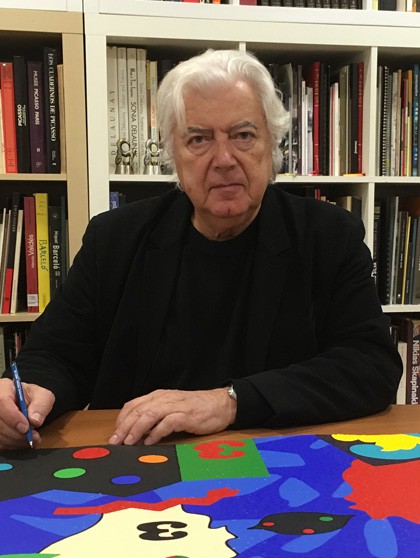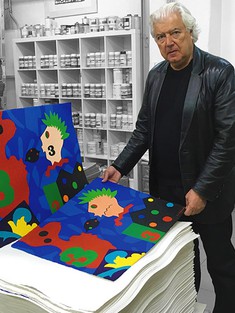
José de Guimarães
"Artists always seek to achieve that which is most sublime"
José de Guimar´es is He is considered one of the main Portuguese visual artists of Contemporary Art, having a vast and notable work in painting, sculpture and other creative activities, which makes him one of the most awarded Portuguese visual artists. Many of his works are exhibited in several European museums, as well as in the United States of America, Brazil, Canada, Israel and even Europe. in Japan.
In 2012, the José de Guimarães (CIAJG), dedicated to the contemporary art and bringing together pieces from the artist's collections of African Art, Pre-Columbian Art and Ancient Chinese Art.
José de Guimarães has always given particular attention and demands to the your graphic work. Since 1962, He created close to 400 works, exploring various techniques. Recently he made the second donation of Graphic Work to the company. National Library of Portugal which includes all editions made since 1991.
Introducing now to second special edition, we talked to the artist.
What importance do you attribute to graphic work and the multiple in the context of your work?
Interestingly, I started my life as an artist as a printmaker. I started at the Sociedade Cooperativa de Gravadores Portugueses in 1958/59, which was great, because I learned a new technique. At the time there was mainly metal engraving, wood engraving and little else; Later, I learned lithography in Switzerland, when I made the first edition, lithography with transfer (I drew on a special sheet, with glue, and transferred it onto a lithographic stone). Later, I immersed myself in the world of screen printing, which, from a technical point of view, is, for me, the most difficult. Because there is a side of technical apparatus where photography is also involved. fundamental. That was the reason I had a scholarship from Gulbenkian for two years to study photographic screen printing. Within the scope of this scholarship, I made some of the most important engravings in my history, namely the entire 1st series. de Maio, which has technical processes of overlapping shapes that play with the various solvents, which react with each other. These are difficult techniques, which require dedication and constant practice. But, in fact, in general, in my career, when I developed new series in painting (Rubens series, Mexico, Camoniana, fetishes, etc.), I also always edited multiple, in screen printing, lithography, wood engraving, etc. The edition of multiples allows people with less economic capacity to acquire works numbered and signed by the artists, with the quality of an original.
As part of the donation of the second set of graphic work to the National Library, comprising almost 400 works, what plans are there for the future?
What is happening? Planned for 2019 is a large exhibition of all the work in the National Library's collection. At that time it will be A catalog has been publishedraisonné with all the graphic work published up until the end of the year. to date.
This means that this universe will be It is more dignified because, unfortunately, there is still a certain stigma regarding the disease. graphic work…
But this is a problem. here in Portugal because, for example, in Spain graphic work is required. extremely important. The greatest Spanish painters have an extensive graphic work: Miró, Picasso, Tapiès, younger ones, etc. In France the same thing happens. My editions, published in France, are all in the National Library of Paris, in the so-called Legal Deposit. I'm not even the one dealing with this, it's just me. This is an obligation on the part of editors from the outset.
Just as we have a protocol with the National Library for the donation of works, for dignification , preservation and future memory of our editions…
Of course.
While the previous silkscreen printed by the CPS evoked Pessoa, this one, now presented, pays tribute to Camões. How do you see? What is the redefinition of Portugueseness through this poet?
Camões is He is a poet who has always interested me, not only for his poetic art, ability for synthesis, but also for the life he led, a passionate, a brave man, someone who internalized the History of Portugal better than anyone else. When I go on vacation I always take the Lusíadas with me. I may not take anything else but I always take the Lusíadas. And I'm reading. Now I read, reread and will read again. It's part of my genes.
More specifically, what meaning do you attribute to the phrase? relationship between Camõdinamene and the symbolism of this silkscreen?
They say that Dinamene died in a shipwreck and she appears there as if she were a shipwreck, but Camões still talks to her, to his loved one. É It is a scene of passion, between the poet and his muse.
Considering culture as a manifestation of the aggrandizement of societies, how does direct coexistence with the work of Does art contribute to the improvement of contemporary society?
Artists always try to achieve what is best for them. more sublime, more spiritual, what communicates better… I think your activity is good for the world. If it weren't like this, you wouldn't understand what it was for. Art is part of the growth of the spirit.
